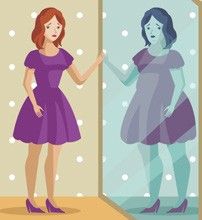EATING DISORDERS IN MIDLIFE by Oana Oancea, RD
Posted on
Oana Oancea, Specialist Dietitian in Eating Disorders (EDs) summarises the issues surrounding disorders eating in adults. Here she looks at causes, risks and treatment.
 Despite the fact that EDs are equal opportunity offenders, crossing cultural boundaries and leaping the borders of age and gender, very little research has been done to better understand these disorders in midlife (commonly defined as the period between 35 and 55 years).
Despite the fact that EDs are equal opportunity offenders, crossing cultural boundaries and leaping the borders of age and gender, very little research has been done to better understand these disorders in midlife (commonly defined as the period between 35 and 55 years).
The context in which people in midlife experience them is quite unique.
PREVALENCE
There are more midlife adults with symptoms of EDs than those with an official ED diagnosis.
Research shows that around 3.6% of women aged 40 to 50 years experience an ED every year. Based on DSM-5 criteria, other specified feeding and eating disorders (OSFED; 1.7%), (considered as one disorder) is the most common ED found in this age group, followed by binge-eating disorder (BED; 1%), bulimia nervosa (0.4%) and anorexia nervosa(0.2%).1
EDspecialist, Dr Holly Grishkat, considers that midlife or older women living with EDs essentially fall into three categories:2
- Those who have struggled with an ED for years without seeking treatment
- Those who had an ED as a teen or young adult and recovered, only to relapse in midlife
- Those who develop an ED for the first time in midlife
CAUSES
EDs are most often thought of as afflicting teenage girls and young women. There is also growing evidence to show that EDs aren't exclusive to people under the age of 30. Here are the main two causes of EDs in midlife:
- Perimenopause is a time characterised by shifts in hormone levels. Because of this, some researchers hypothesise that the hormone fluctuations occuring in perimenopause could also be a risk factor for the development or maintenance of EDs in midlife in women.
- Body image issues: Age-related weight gain and changes in body composition – including an increase in body fat, reduced skin firmness, fat redistribution and changing body shape, and decreased metabolism – can also cause many women (and presumably men, too) to feel dissatisfied with their appearance, which can lead to unhealthy eating habits. According to a 2006 study conducted by Austrian researchers, even women in their 60s were unhappy with their weight and body shape, and a small percentage suffered from full-blown EDs. The researchers found that among 475 women aged 60 to 70 years old, 60% said they were dissatisfied with their bodies and 4% met the criteria for an ED diagnosis.
Other causes include:
- Relationship problems (such as divorce or infidelity)
- The death of a partner or spouse
- Retirement or loss of a job
- Empty-nest syndrome
- Caring for aging parents
- Lacking adequate savings for retirement
- Grief (including that brought on by the death of a loved one or a pet)
- Dealing with increased illness
- Lack of enthusiasm for life
- Attempts to get attention from family members
- Growing old/facing death
RISKS
EDs can have devastating effects and they are even more dangerous to older adults. The effects may be heightened for those who have been chronically ill with an ED for many years.
Potential medical consequences associated with EDs include:
- Osteoporosis
- Increased risk of high blood pressure
- Increased risk of diabetes
- Heart problems such as arrhythmia, heart disease, and heart failure
- Anaemia
- Cognitive problems
- Electrolyte abnormalities
- Kidney issues
TREATMENT
One study showed that only 27% of midlife women who met the criteria for an ED diagnosis received no treatment.3
A middle-aged person may be more reluctant to acknowledge and seek help due to the misbelief that older people do not (or should not) get EDs. There may even be added shame and embarrassment related to experiencing what is often mistakenly perceived as “an adolescent problem.”
Given the similarity in presentation and course between EDs in midlife and young adulthood, treatment options include:
- Cognitive-behavioral therapy (CBT)
- Group therapy
- Family-based treatment (FBT)
- Interpersonal therapy
- Nutritional therapy
It is vital to recognise the symptoms and learn how to help and care for these middle-aged patients taking into consideration the increasing prevalence of eating disorders among older adults. The contributions of dietitians can't be overestimated as they can provide middle-aged patients and their families the optimal means and support for a better quality of life.
Oana Oancea, RD
Eating Disorder and Mental Health Specialist Dietitian
Dumfries and Galloway NHS
References
- Micali N, Martini MG, Thomas JJ, et al. Lifetime and 12-month prevalence of eating disorders amongst women in mid-life: A population-based study of diagnoses and risk factors. BMC Med. 2017;15(1):12. doi:10.1186/s12916-016-0766-4
- Rowell S. Eating Disorders and Older Adults. CSA Journal. 2020;78(1).
- Micali N, Martini MG, Thomas JJ et al. Lifetime and 12-month prevalence of eating disorders amongst women in midlife: A population-based study of diagnoses and risk factors. BMC Med. 2017;15(1):12. doi:10.1186/s12916-016-0766-4
